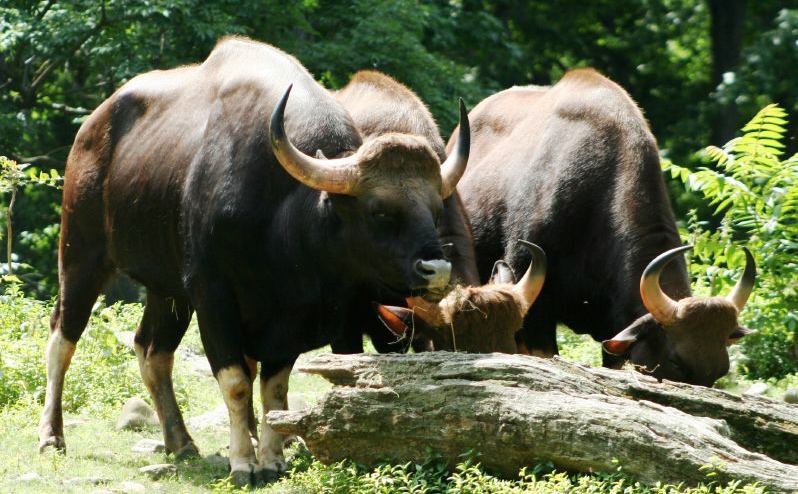|
Tami Nadu - Wildlife of Tamil Nadu - Gaur of Tamil Nadu
Gaur at Tamil Nadu
The gaur is a large, dark-coated bovine animal of South Asia and Southeast Asia. The biggest populations are found today in India. The gaur is the largest species of wild cattle, bigger than the African buffalo, wild water buffalo or bison. It is also called seladang or in the context of safari tourism Indian bison. The domesticated form of the gaur is called gayal or mithun.
The gaur has a high convex ridge on the forehead between the horns, which bends forward, causing a deep hollow in the profile of the upper part of the head. There is a prominent ridge on the back, and there is no distinct dewlap on the throat and chest. The flattening of the horns at the base is very decided, and the horns are regularly curved throughout their length, and are bent inward and slightly backward at their tips. The ears are very large, the tail only just reaches the hocks, and in old bulls the hair becomes very thin on the back. |
 |
Gaur are said to look like water buffalo at the front and domestic cattle at the back. They are the heaviest and most powerful of all wild cattle. Males have a highly muscular body, with a distinctive dorsal ridge and a large dewlap, forming a very powerful appearance. Females are substantially smaller, and their dorsal ridges and dewlaps are less developed.
* Body length: 250–360 centimetres (8–10 ft).
* Shoulder height: 170–220 centimetres (6–7 ft). On average, males stand about 180–190 centimetres (5 ft 11 in–6 ft 2.8 in) at the shoulder, females about 20 centimetres (8 in) less.
* Tail length: 70–100 centimetres (28–39 in).
* Weight: Males often 1,000–1,500 kilograms (2,200–3,300 lb), females 700–1,000 kilograms (1,500–2,200 lb). Weight vary between subspecies. Among the three subspecies, the South-east Asian gaur is the largest, and the Malayan gaur, or seladang, is the smallest. The male Indian gaur average 1,300 kilograms (2,900 lb), and the largest individuals may exceed 2,000 kilograms (4,400 lb)[citation needed]; whereas a Malayan gaur usually weigh 1,000–1,300 kilograms (2,200–2,900 lb). The largest of all gaur, the southeast Asian gaur, weigh about 1,500 kilograms (3,300 lb) for an average male.
Gaur bull with the typical high dorsal ridge
The dark brown coat is short and dense, while the lower legs are white to tan in colour. There is a dewlap under the chin which extends between the front legs. There is a shoulder hump, especially pronounced in adult males. The horns are found in both sexes, and grow from the sides of the head, curving upwards. Yellow at the base and turning black at the tips, they grow to a length of 80–32 centimetres (31–13 in). A bulging grey-tan ridge connects the horns on the forehead.
Dimensions of gaur horns
The horns are flattened to a greater or less degree from front to back, more especially at their bases, where they present an elliptical cross-section; this characteristic being more strongly marked in the bulls than in the cows. The tail is shorter than in the typical oxen, reaching only to the hocks. The animals have a distinct ridge running from the shoulders to the middle of the back; the shoulders may be as much as 12 centimetres (5 in) higher than the rump. This ridge is caused by the great length of the spines of the vertebrae of the fore-part of the trunk as compared with those of the loins. The hair is short, fine and glossy, and the hoofs are narrow and pointed.
|
